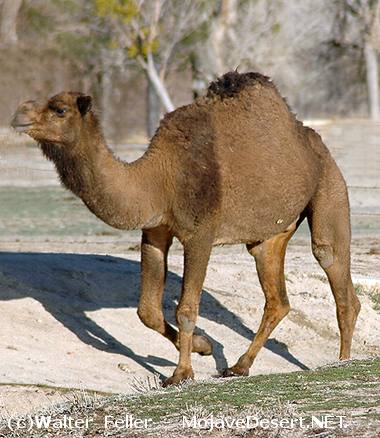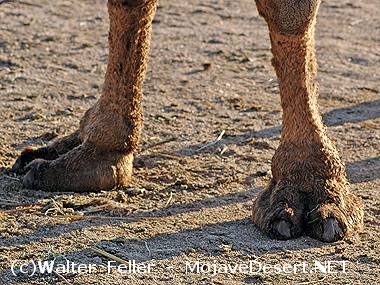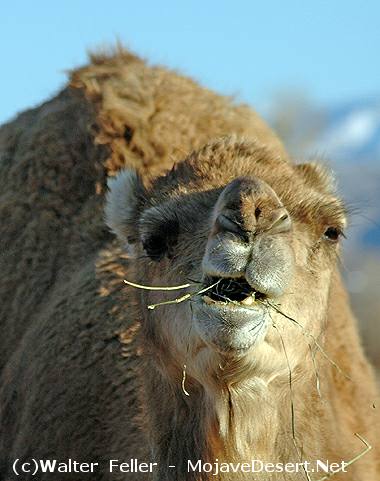Camel Expedition
1857-58
The Secretary of War, Jefferson Davis, wanted to test the use of camels as
desert transportation for military equipment and supplies vs. horses and
mules. He assisted in acquiring $30,000 for an expedition to go to Egypt and
bring back 70 camels for the test trek. The camels fared the sea crossing well
and arrived at Indianola, Texas on 14 May 1856.
Navy Lieutenant Edward F. Beale was tasked to conduct a survey for a
wagon/camel route from Fort Defiance, New Mexico Territory (today's northeastern
Arizona) to the
Colorado River
and from Fort Mohave (western Arizona) along the
35th Parallel
to
Fort Tejon,
California. He was also to
test the fitness and service of the camels for the Army as a replacement of the
horses and mules in the desert.
Lt. Beale began with 70 camels and 150 sheep. Most of the soldiers rode
their horses and used the camels for transports. They did not believe that
camels would be as reliable as horses. The sheep were for fresh meat so that
the soldiers would not need to lose time hunting.
Try to picture what it must have been like for the Native Americans who had
not seen many white men and now here is an olive-brown Arab in traditional
clothing, speaking a language that none could seem to understand. Along
with a strange looking "desert devils": dromedary (one hump) camels used for
riding; bactrain (two humps) camels for carrying the cargo; and Mexican
woolly sheep. This must have been a sight to behold.
The Camel Expedition officially did not set foot directly on today's Fort
Irwin. Lt. Beale and Hi-Jolly (Hadji Ali), the camel driver, rode horses to
Bitter Springs as a potential route leading into other parts of the desert.
They did determine that the water was too bitter for animals and man alike.
Lt. Beale sent five men on horseback out to find water. When they did not
return, he sent Hi-Jolly on his camel to locate them. Hi-Jolly saw the five
men being attacked by a band of (Indians) Native Americans. Once Hi-Jolly
realized he did not have time to go for help, he drew his Scimitar an Arabian
sword and charged them yelling "Bismiallah" (God is Great) with his great
cap flapping in the wind. The (Indians) Native Americans had never seen a
camel or such a rider and fled in a state of terror. They said that they saw a
"desert demon flying out of the sky".
After reaching Fort Tejon, Lt. Beale decided that the camels' performance
far exceeded that of the horses and mules for desert transportation, but were
not compatible with soldiers. The camels had a nasty personality, bit, spat
and made lots of noise when they walked. These were not the types of things
the military would tolerate and the camels were released into the desert.
Comparison: Horses vs. Camels
Could camels swim the Colorado River?
Lt. Beale could not get them to set foot into the water. Hi-Jolly led the oldest
male camel to the water's edge for a drink. With little effort, Hi-Jolly led the
camel into the water and all 70 crossed without incident. Unfortunately, 8
horses and 14 mules drowned during the crossing.
How did the camels compare in cold weather?
In January, Lt. Beale pitched his camp within a few hundred yards of the
summit of the Sierra Nevada mountains. His camels thrived happily and
grew fat in two to three feet of snow. During a snowstorm camels were sent
to rescue stranded wagons, people and mules. The camels brought the load
through ice and snow back to camp. A strong six-mule team was unable to
extricate the empty wagons. Yet the camels seemed to pull them out with
little effort. The camels were sent back to retrieve the mules, which were
freezing to death. The mules were tied up on the sides of the camels and
carried out of the snow and mountains.
Would the leathery, hoof less feet of the camel carry them across the stony
southwest desert?
The camel has no shuffle in its gait, but lifts its foot perpendicularly from the
ground and replaces it without sliding. The camel's coarsely granulated
footpad enables it to travel continuously in a region where other beasts could
not last a week. They survived in both deserts and snow-bound areas with
equal agility.
How often do the camel and the horse need water?
A horse needs 8-12 gallons of water 2-3 times a day in the desert. A camel
can go 10-12 days without water. Horses need special foods whereas camels
eat almost any desert vegetation. Horses do not perform well under extreme
heat or cold. Neither seems to effect camels. Camels gained weight in snowbound
areas because they could eat the available winter vegetation and get
water from eating snow.
How much of a load can a camel carry?
A horse can carry 170-250 lbs. and walk 30-40 miles in a day with stops and
watering. A camel was tested over several days with increasing load. The
camel carried up to 1,256 pounds 40-45 miles in a day at one continuous
speed, but needed a day or two rest. But normally they found a 600-800 lbs.
load was more acceptable for the camel and could carry it for several days.
As in all pack animals, you unload each night and reload the next day.
How do camels compare for riding?
On a special trip away from camp, Lt. Beale rode his camel, Sid, eight miles
an hour with "least effort" and traveled twenty-seven miles in three hours.
Generally a horse under normal conditions travels 35 miles over an 8 hours
period, but would need rest the next day or a shorter trip allowing rest. The
dromedary was used for riding and the bactrain carried the cargo.
Why did the camels fail the experiments?
In spite of the fact that they exceeded in most challenges, they scared the
horses, mules and all animals in general. The soldiers could bond with a
horse, but no one was able to bond with a camel. The camelís bit, spat, made
noises when they walked, and had a nasty personality worse than any mule.
The Camel Express
Beale's Wagon Road
Edward F. Beale
To satisfy part of his transportation needs, Beale took 25 camels, imported from Tunis, as pack animals during this expedition ...Fort Tejon
Fort Tejon was located in the Canada de las Uvas, about 15 miles southwest of the ...Mojave Road


